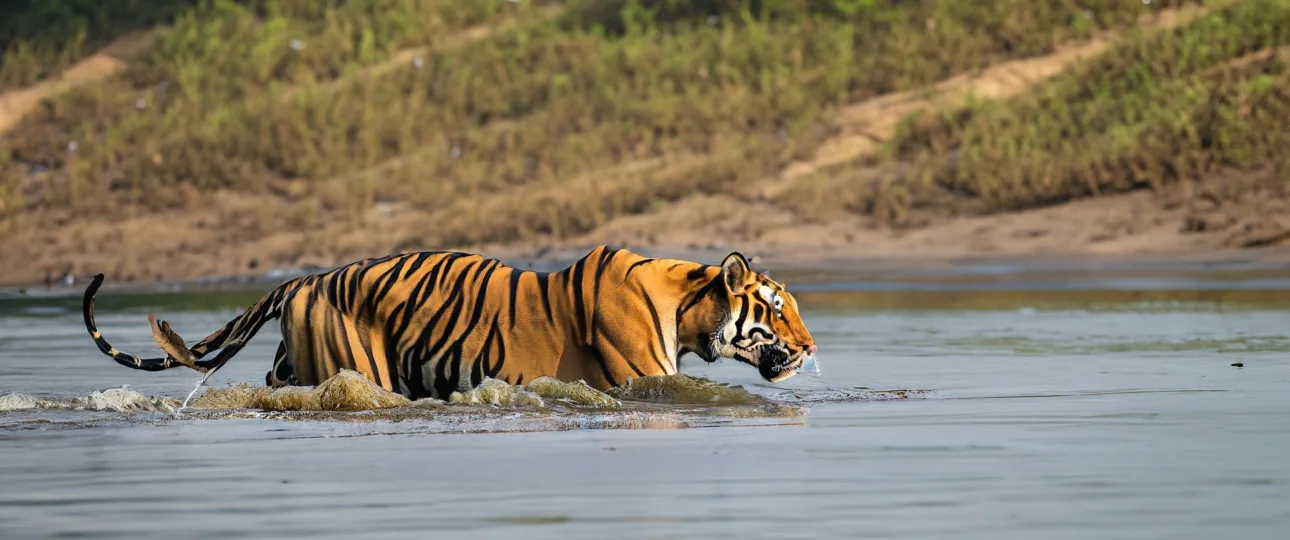Table of Contents:
- Introduction
- The Enigmatic Sundarbans
- 2.1 Geography of Sundarbans
- 2.2 Biodiversity and Wildlife
- A Glimpse into Sundarbans’ History
- 3.1 Ancient Origins
- 3.2 Colonial Era
- 3.3 Post-Independence
- The Administrative Landscape
- 4.1 Sundarbans Reserve Forests
- 4.2 Wildlife Sanctuaries and National Parks
- 4.3 Conservation Efforts
- Experiencing Sundarbans
- 5.1 Ecotourism
- 5.2 Unique Experiences
- 5.3 Sundarbans Today
- Frequently Asked Questions (FAQ)
- Conclusion
Introduction:
Welcome to the enchanting world of the Sundarbans, a place where nature meets history, and wildlife thrives in the heart of the Bay of Bengal. In this comprehensive blog, we’ll embark on a journey through the Sundarbans, covering its geographical marvels, storied past, and the administrative mechanisms that protect its fragile ecosystem.
- The Enigmatic Sundarbans
2.1 Geography of Sundarbans: A Natural Marvel at the Delta’s Edge
The Sundarbans forest is an awe-inspiring natural wonder situated within the vast delta at the confluence of the Hooghly, Padma, Brahmaputra, and Meghna rivers, along the southern coastal region of Bangladesh. Encompassing approximately 10,000 square kilometers (3,900 square miles), with roughly 6,517 square kilometers (2,516 square miles) residing in Bangladesh and an estimated 3,483 square kilometers (1,345 square miles) in India, it’s a region of remarkable ecological significance.
This region’s geographical tapestry comprises the seasonally flooded Sundarbans freshwater swamp forest, nestled inland beyond the coastal fringe of mangrove forests. However, it’s the intricately woven network of waterways that truly defines the Sundarbans. A complex web of tidal channels, mudflats, and resilient salt-tolerant mangrove forest-covered islands crisscrosses the entire area.
The unique design of this natural labyrinth offers unparalleled accessibility. Almost every nook and cranny of the Sundarbans is reachable by boat, allowing adventurers and nature enthusiasts to explore its hidden corners.
But it’s not just about accessibility; it’s also about biodiversity. The Sundarbans is renowned for its rich wildlife, with the iconic Bengal tiger taking center stage. Yet, it’s not the sole star of the show; the region is home to a plethora of fauna, including a variety of bird species, chital deer, crocodiles, and various snake species.
Centuries of human interaction have left their mark on the fertile delta soils, transforming much of the ecoregion into intensively cultivated farmland. However, amidst this landscape of human activity, pockets of pristine forest remain, their importance amplified as they serve as vital habitats for the endangered tiger.
Beyond its ecological significance, the Sundarbans is a lifeline for the millions of residents in and around Khulna and the Port of Mongla. It acts as a natural shield against the ravages of cyclones, tsunamis, and coastal erosion, providing a crucial protective barrier for coastal populations.
In essence, the geography of the Sundarbans is a masterpiece of nature, where lush forests and intricate waterways coalesce, offering a sanctuary for wildlife and a guardian for human communities against the relentless forces of the sea.
2.2 Biodiversity and Wildlife:
Discover the astonishing biodiversity of the Sundarbans. From Royal Bengal tigers to saltwater crocodiles and diverse bird species, this region is a wildlife enthusiast’s paradise.
- A Glimpse into Sundarbans’ History
3.1 Ancient Origins: Uncover the ancient roots of the Sundarbans and its historical significance in the region’s culture and trade.
3.2 Colonial Era: Explore how the British colonial period influenced the Sundarbans, from resource extraction to conservation efforts.
3.3 Post-Independence: Learn about the challenges and progress made in the Sundarbans after India and Bangladesh gained independence.
- The Administrative Landscape
4.1 Sundarbans Reserve Forests: Delve into the administrative setup that protects the Sundarbans, including the Sundarbans Reserve Forests and their significance.
4.2 Wildlife Sanctuaries and National Parks: Discover the designated wildlife sanctuaries and national parks within the Sundarbans and their role in conservation.
4.3 Conservation Efforts: Learn about the ongoing conservation efforts and challenges faced in safeguarding this fragile ecosystem.
- Experiencing Sundarbans
5.1 Ecotourism: Plan your visit to the Sundarbans responsibly through ecotourism initiatives that promote conservation and awareness.
5.2 Unique Experiences: Explore the various activities and experiences the Sundarbans offer, from boat safaris to cultural encounters with local communities.
5.3 Sundarbans Today: Gain insight into the current state of the Sundarbans and its importance in the context of climate change and biodiversity conservation.
Frequently Asked Questions (FAQ)
Q1: When is the best time to visit the Sundarbans?
A1: The best time to visit the Sundarbans is during the winter months, from November to February. The weather is pleasant, and wildlife sightings are more frequent. However, be prepared for cooler evenings.
Q2: Are there any safety concerns in the Sundarbans?
A2: While the Sundarbans offer incredible experiences, it’s essential to be cautious. Be aware of wildlife, follow your guide’s instructions, and carry necessary safety equipment, like mosquito repellent and first-aid supplies.
Q3: How can I explore the Sundarbans responsibly?
A3: To explore the Sundarbans responsibly, choose eco-friendly tour operators, follow wildlife conservation guidelines, and support local communities. Avoid littering and respect the delicate ecosystem.
Q4: What permits or permissions are required to visit the Sundarbans?
A4: You’ll need permits from the respective forest departments of India and Bangladesh to visit the Sundarbans. These can be obtained through authorized tour operators.
Q5: Is it possible to see a Bengal tiger in the Sundarbans?
A5: While Bengal tigers inhabit the Sundarbans, sightings are rare due to their elusive nature. However, experienced guides increase your chances of spotting these magnificent creatures.
Q6: What should I pack for a trip to the Sundarbans?
A6: Pack light, breathable clothing, comfortable walking shoes, a hat, sunscreen, insect repellent, a waterproof camera, and any necessary medications. Don’t forget to carry essentials like water bottles and snacks.
Q7: Are there any cultural experiences available in the Sundarbans?
A7: Yes, you can engage with local communities, learn about their culture, and even participate in traditional activities like folk dances and crafts.
Q8: How can I contribute to the conservation of the Sundarbans?
A8: You can contribute to Sundarbans conservation by supporting responsible tourism, avoiding single-use plastics, and donating to reputable conservation organizations working in the area.
Q9: Are there accommodation options within the Sundarbans?
A9: Accommodation options vary from rustic eco-cottages to more comfortable lodges on the fringes of the Sundarbans. It’s advisable to book in advance, especially during peak tourist seasons.
Q10: Can I explore the Sundarbans independently, or do I need a guided tour?
A10: While it’s possible to explore some parts independently, it’s highly recommended to opt for a guided tour. Experienced guides are familiar with the terrain, wildlife behavior, and safety protocols, enhancing your overall experience.
- Conclusion
In conclusion, the Sundarbans is not just a geographical wonder; it’s a treasure trove of history, biodiversity, and administrative complexities. By understanding its past, appreciating its beauty, and supporting its conservation efforts, we can ensure that this unique ecosystem continues to thrive for generations to come. Plan your visit to the Sundarbans today and be part of its incredible story.




